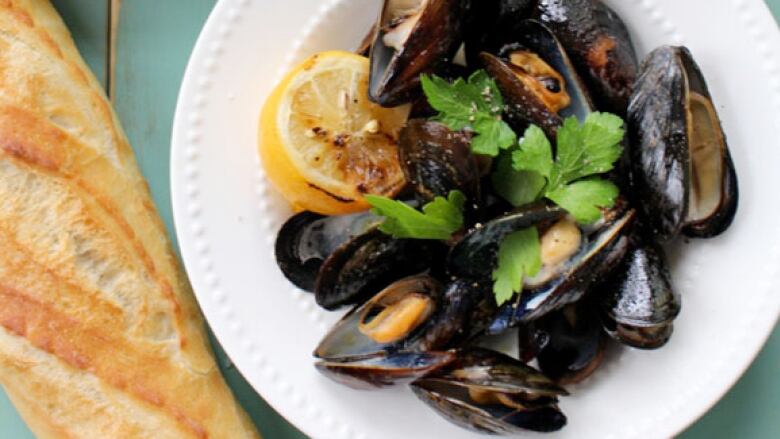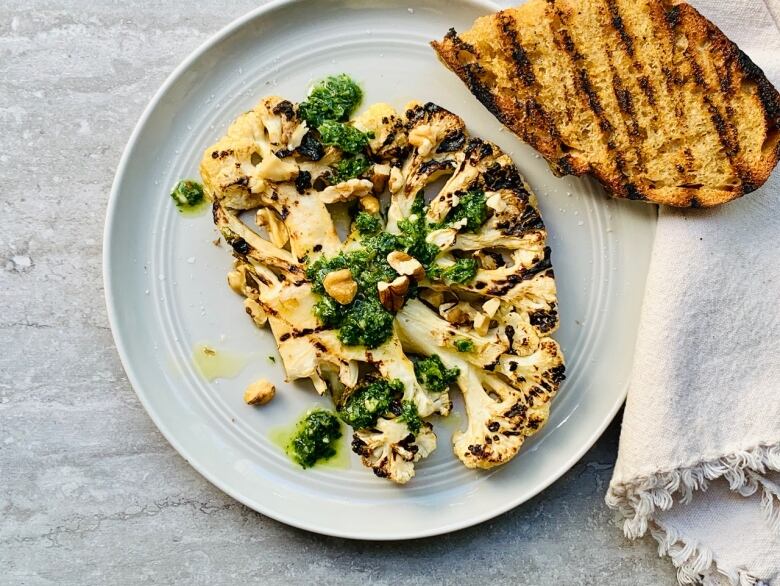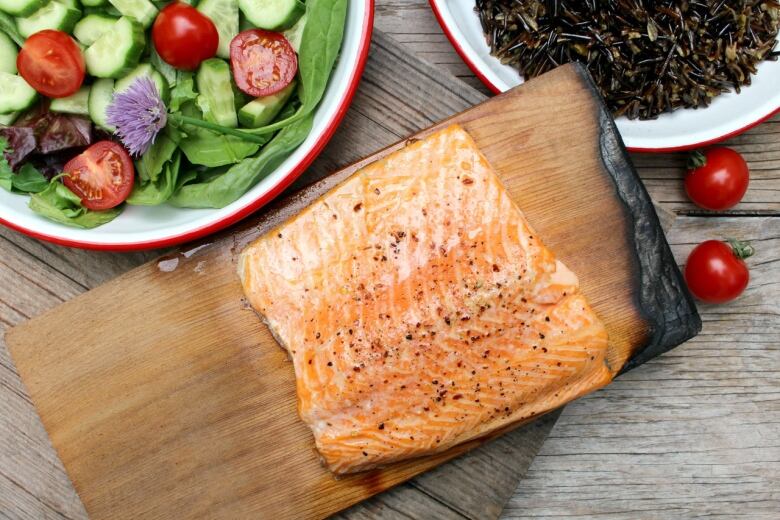Spice up the BBQ with salmon, mussels and cauliflower steak
CBC food columist Julie Van Rosendaal offers tips on barbecuing more than burgers

Most of us have spent more time in our kitchens this spring than usual.
With warm weather coinciding with a particularly urgent need to get outdoors this year, cooking dinner in the backyard has become a popular means of escaping the confines of our usual mealtime spaces.
When considering what to toss on the grill, it's easy to default to burgers, steaks and chicken. Inreality, there are few things you technically can't cook on your backyard barbecue.
Though it may not be ideal for cooking a pot of pasta, a cast iron skillet opens up a ton of possibilitiesfrom pancakes to paella.
When you grill food, you cook it quickly over directintense heat, creating plenty of deeply browned, even charred,bits.
- Bookmarkcbc.ca/juliesrecipesto keep up with all of Julie Van Rosendaal's dishes
Moving food around allows you to control the heat. Moving it to a cooler side of the grillor cooking it over indirect heat allows for lower-temp cooking, making it possible to cook large meats. For indirect heat, imagine the burner turned on one side, with your food moved over to the other sidewith the lid closed.
You can also bakethings that typically require a lower temperature all the way through without them burning on the outside.
Though we often refer to backyard grilling as barbecuing the tool we use is called a barbecue, after all true barbecue is the opposite. It'sfood that cooks low and slow at around 93 C/200 F for up to 24 hours.
That low, slow cookingbreaks down tough connective tissues in cuts like pork shoulder and brisket, making them meltingly tender.
There are plenty of similarities, though. Both are done outdoors and impart a smoky flavour. You can add the flavour of woodsmoke to your grill with planks or chips, or by grilling over hot coals.
Veggies are also perfect for grilling. Anything from potatoes to asparagus can benefit from the intense heat of the grill.
Here are a few recipes to try for cauliflower steaks, grilled mussels with garlic, butter and lemon, and cedar-planked salmon.
Cauliflower steaks
To grill cauliflower steaks, cut vertical cross sections of cauliflower about -inch thick. Brush with oil or turn in a shallow dish with some oil, lemon or lime juice and some garlic, chili flakes or other spices.
Then grill until deeply charred and just tender.
I topped this one with a quick herby green sauce. You can make it with ahandful each of the leafy parts of cilantro and flat-leaf parsley, a clove of garlic, half a jalapeo, a bit of cumin, salt and lime, and enough olive oil to make it saucy.

Grilled mussels with garlic, butter and lemon
Ingredients:
1 lb fresh mussels.
Lemon halves.
Olive oil, for cooking.
cup butter.
1 garlic clove, peeled.
Fresh parsley, for garnish.
Preparation:
While you preheat your grill to medium-high, rinse your mussels. Discardany that are already open. Cut the lemons in thick wedges or in half crosswise.
Scatter the mussels directly on the grill along with the lemons, which should be cut-side down.
Close the lid of the grill and cook for fiveminutes.
Meanwhile, heat the butter and garlic clove in a small saucepan or skillet off to one side.
Remove the mussels from the grill. They should all be open. Discard any that don't.
Transfer to a bowl and drizzle with the garlicky butter; toss to coat.
Transfer to shallow bowls.
Scatter with parsley and serve with crusty bread and grilled lemon.
Serves: Four.
Cedar-planked salmon
Planking is a technique used by Indigenous communities along the West Coast for millennia. This is when a soaked cedar plank is used as a buffer between salmon and the intense heat of the grill. It impartsdelicious flavour to the fish.
When grilling fresh fish directly on the grill, firmer varieties will hold up better, such as salmon, steelhead trout, halibut andtilapia. Cooking it with the skin on can helpand whole fish is easier to handle. You can always pull out your skillet for more delicate fillets.
Try other types of seafood, too. Toss whole shrimp, mussels or clams onto the grill, or even calamari. All will cook very quickly. If you grill halved lemons or limes, cut-side down, they'll get smoky and flavourful as they soften. That makes them easier to squeeze over seafood and other dishes.
Also try grilling slabs of halloumi or paneer, either in a cast iron skillet or directly on the grill. Then drizzle with honey and a squeeze of grilled lemon.
In this recipe, we'll use salmon or steelhead trout fillet.
Make sure you pick up a food-grade plank from your fish monger or the seafood section of the grocery store. You can use your favourite marinade, or just season with salt and let the flavour of the cedar come through.

Ingredients:
1-1.5lb (750 g) salmon or steelhead trout fillet.
Olive or canola oil.
Salt and pepper.
Glaze (optional):
1/3 cup maple syrup.
1 tbsp lemon juice.
1 tbsp soy sauce.
1 garlic clove, crushed.
1 tsp grated ginger.
Preparation:
Soak an untreated cedar plank in water for at least half an hour. This is easy to do in the sink. Just place a pan or other object on the plank to keep it submerged.
Trim your veggies and toss with oil to coat.
Sprinkle with salt and pepper.
In a small bowl, stir together the glaze ingredients, if you're using it. Spread over the surface of the salmon. Otherwise, sprinkle the fish with salt and pepper.
Preheat your grill to medium-high and place your plank on the grill for about fiveminutes, or until it starts to smoulder.
Place the fillet on the plank. Close the lid and cook for about 15-20 minutes, lifting the lid occasionally to check for flares. Continue cooking until the fish is cooked through. You'll know it's done because the fat will rise to the surfaceand the edge should flake with a fork.
Serves: Four.
Listen to Julie Van Rosendaal's Calgary Eyeopener column on cooking on the barbecue:












_(720p).jpg)


 OFFICIAL HD MUSIC VIDEO.jpg)
.jpg)



























































































